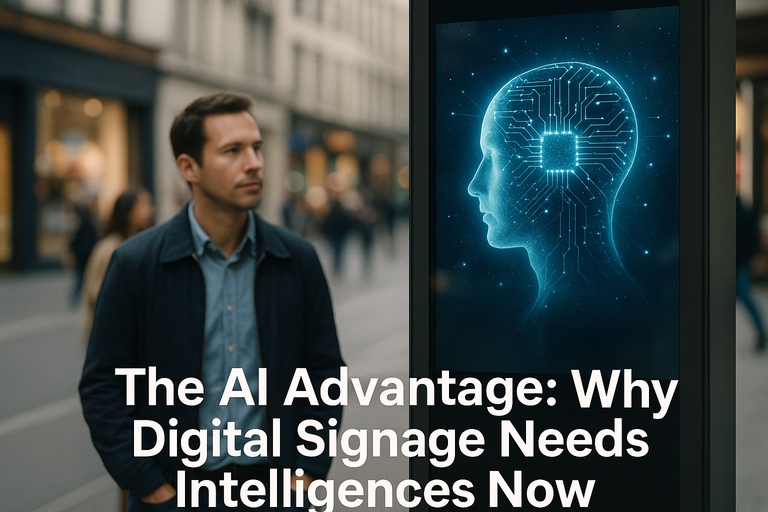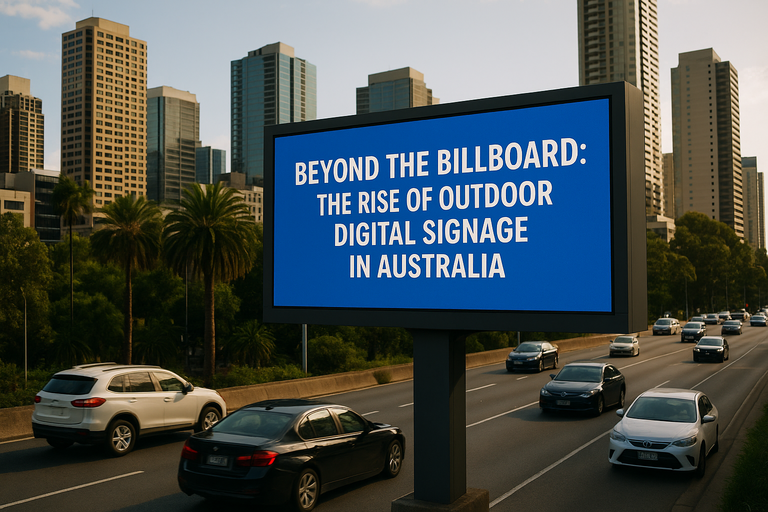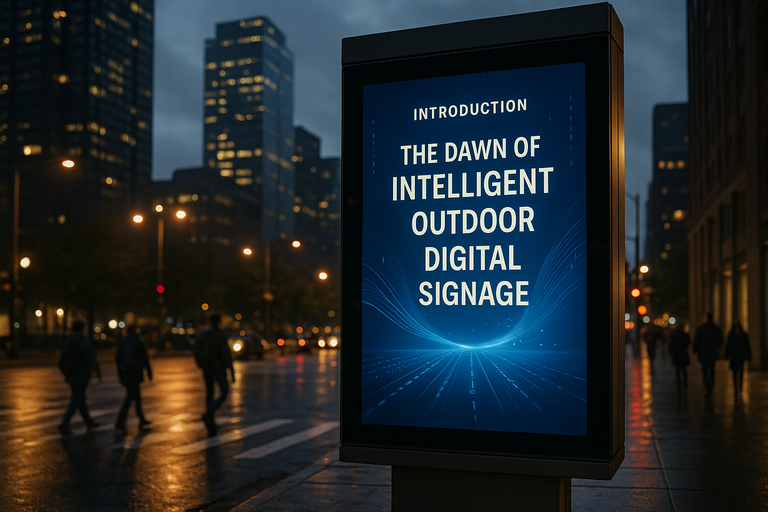From painted wood to neon lights and the high-definition screens that populate our public spaces today, the evolution of signage has been dramatic. Digital signage already transformed our visual landscape, replacing static posters with dynamic, engaging content. But now, it’s getting a brain. The integration of Artificial Intelligence (AI) is sparking a profound transformation, turning passive displays into intelligent, interactive platforms. This shift is not just a novelty; it is a strategic tool that is redefining customer and patient engagement, especially within the restaurant and healthcare sectors. This article explores how AI is the new engine driving the future of digital signage, creating smarter, more responsive, and incredibly effective communication systems.
The New Brains of the Operation: What is AI-Powered Digital Signage?
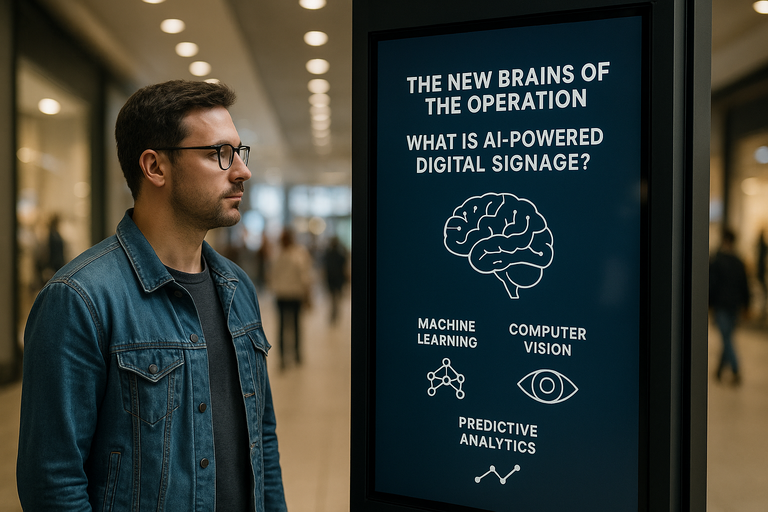
At its core, traditional digital signage excels at delivering pre-programmed content to a wide audience. Think of airport arrival screens or mall directories. However, AI-powered digital signage introduces a dynamic, cognitive layer. It moves beyond a fixed playlist to a system that can perceive, analyze, and react to its environment in real time. It’s the difference between a monologue and a conversation. This evolution leverages a suite of powerful technologies to deliver content that is not just displayed, but is intelligently selected and optimized for the current moment.
The primary technologies fueling this revolution include machine learning, computer vision, and predictive analytics. Computer vision acts as the system’s “eyes,” anonymously detecting audience demographics like age range, gender, and even emotional state through facial analysis. Consequently, a display can autonomously switch from a toy advertisement to a luxury car commercial based on who is watching. Machine learning algorithms then process this data, alongside other inputs like time of day, weather, and sales figures, to learn what content performs best under specific conditions. Over time, the system becomes progressively smarter, ensuring the right message reaches the right person at the right time. This makes modern digital signage a highly adaptive tool.
Predictive analytics takes this a step further. Instead of just reacting, it anticipates. By analyzing historical data, an AI-powered system can forecast future trends. For example, it might predict a surge in foot traffic during a local festival and automatically schedule relevant promotions. This proactive capability transforms digital signage from a simple display into a strategic asset that can directly influence business outcomes, making it a cornerstone of modern marketing and communication strategies.
Transforming the Diner’s Journey: AI in Restaurant Digital Signage
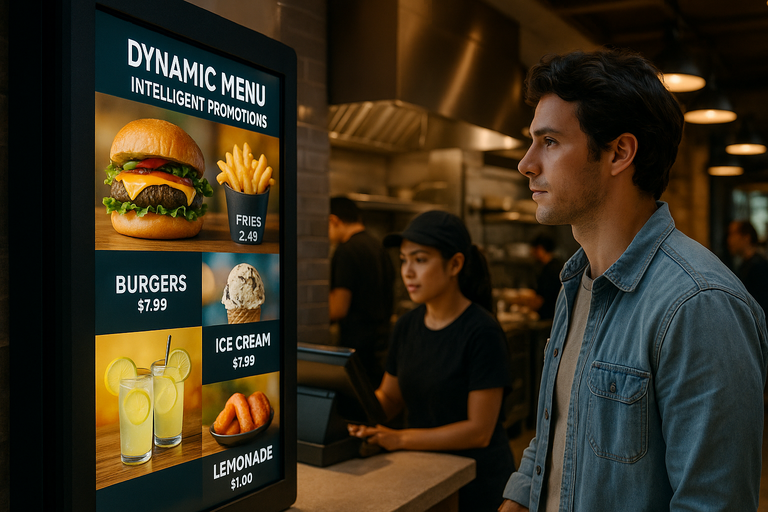
The restaurant industry was an early adopter of digital displays, primarily for menu boards. These screens offered clear advantages over static signs, allowing for easy updates and vibrant, appetizing visuals. Now, AI is supercharging restaurant digital signage, turning it into a central nervous system that enhances everything from the customer’s ordering experience to the kitchen’s efficiency. This intelligent evolution addresses key industry challenges like fluctuating demand, customer personalization, and operational bottlenecks.
Dynamic Menus and Intelligent Promotions
One of the most impactful applications of AI in this space is the creation of dynamic menus. An AI-integrated system can adjust menu offerings and pricing automatically based on a variety of real-time factors. For instance, if the weather forecast predicts a hot afternoon, the system can prominently feature cold beverages and ice cream. If the kitchen is running low on a specific ingredient, the AI can remove that item from the menu or suggest an alternative, preventing customer disappointment. Furthermore, it can implement dynamic pricing, offering a slight discount during off-peak hours to attract more customers or promoting high-margin items during the lunch rush to maximize profitability. This makes restaurant digital signage a powerful tool for inventory management and revenue optimization.
Personalized Experiences and Upselling
AI also enables a level of personalization that was previously impossible. Using computer vision, a restaurant digital signage system can identify customer segments. When a family approaches the counter, the display might highlight kids’ meals or family-sized combos. For a solo diner who appears to be in a hurry, it might showcase quick-service options. This targeted approach feels more helpful and less intrusive than a generic display. Some systems can even integrate with loyalty apps. When a returning customer scans a QR code, the menu board could greet them by name and suggest new items based on their previous order history, creating a truly bespoke and engaging experience that encourages repeat business and higher spending.
Enhancing Patient Care with Healthcare Digital Signage
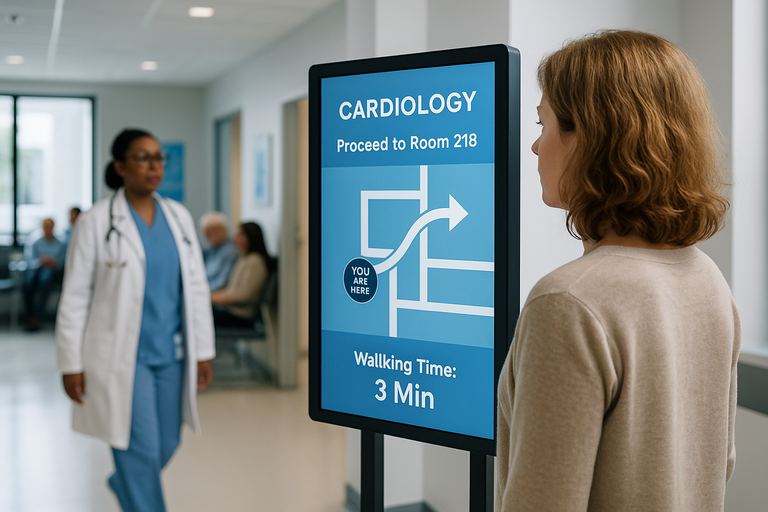
In healthcare settings, communication is critical. Confused patients, long wait times, and a high-stress atmosphere can negatively impact the overall care experience. Healthcare digital signage has already made significant inroads by providing general information, directional guidance, and health-related content. However, the integration of AI elevates these displays from simple information kiosks to active participants in the patient journey, fostering a calmer, more efficient, and patient-centric environment.
Intelligent Wayfinding and Reduced Anxiety
Navigating a large hospital or clinic can be a daunting task, especially for anxious patients. AI-powered wayfinding is a game-changer. After checking in, a patient can receive personalized directions to their specific destination on the nearest screen. These systems can even calculate the walking time and provide landmarks. If a corridor is temporarily blocked, the AI can instantly reroute the path and update the display, ensuring the information is always accurate. By reducing the stress of navigation, healthcare digital signage contributes directly to a better patient experience from the moment they arrive. This sophisticated use of digital signage showcases its utility beyond mere advertising.
Context-Aware Content in Waiting Areas
Waiting rooms are often a source of anxiety. AI can transform this downtime into a more positive and productive experience. By integrating with the hospital’s appointment system, the healthcare digital signage can display contextually relevant information. For example, screens in a cardiology waiting area can show content about heart-healthy diets or stress management techniques. Computer vision can also anonymously gauge the overall mood of the room; if it detects heightened stress levels, the system could automatically switch to calming visuals and soothing audio. Furthermore, it can display accurate, dynamic wait times, which manages expectations and gives patients a sense of control, significantly reducing perceived wait times.
The Future is Intelligent: Trends and Considerations
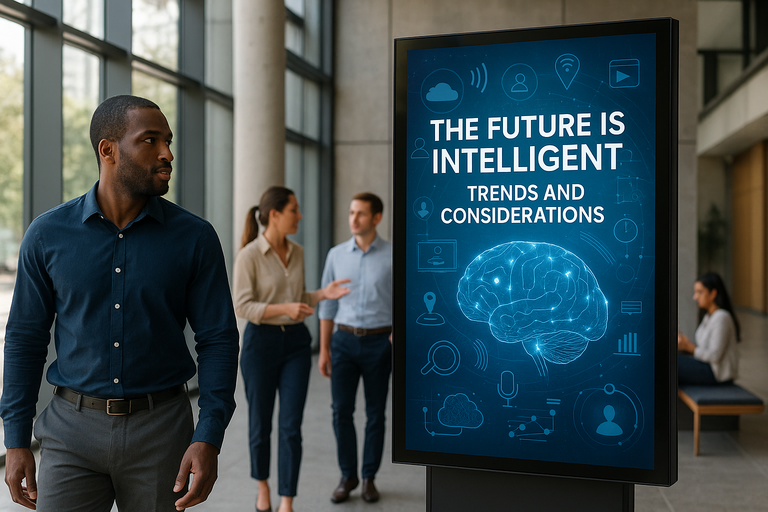
The convergence of AI and digital signage is still in its early stages, but its trajectory is clear. The technology is rapidly evolving, driven by more powerful processors, sophisticated cloud platforms, and increasingly clever software. Looking ahead, we can expect even deeper integration and more interactive capabilities. Voice activation could allow a customer to ask a menu board about ingredients, while gesture controls could enable a patient to explore a 3D map of the hospital.
The true potential lies in data synthesis. Future systems will connect to an even wider array of data sources, from IoT sensors monitoring room occupancy to public transit schedules affecting foot traffic. This will enable a level of predictive accuracy and content personalization that is difficult to even imagine today. A city-wide digital signage network could adjust public health alerts based on real-time environmental data, while a retail chain could tailor in-store promotions based on social media trends.
Of course, this evolution comes with important responsibilities. As these systems collect and analyze data, maintaining privacy and ensuring ethical use is paramount. Transparency will be key; people should understand what data is being used and why. The goal is to create systems that are helpful and responsive, not intrusive. When implemented thoughtfully, AI-powered digital signage promises a future where our physical environments are more seamlessly integrated with the digital world, providing us with timely, relevant, and useful information exactly when we need it.
We are moving decisively beyond the era of static billboards and simple looping videos. The fusion of artificial intelligence with digital signage is forging a new frontier in communication. It transforms displays into intelligent endpoints that can see, learn, and adapt. In the fast-paced restaurant industry, this means streamlined operations and personalized upselling. In the critical healthcare sector, it translates to reduced patient anxiety and clearer communication. The underlying principle is the same: delivering smarter, more relevant content that enhances the human experience. As AI technology continues to mature, the capabilities of digital signage will only expand, cementing its role as an indispensable tool for businesses and institutions aiming to connect with their audiences in a more meaningful and effective way. The future of communication is not just digital—it is profoundly intelligent.

